- A problem is broken into a discrete series of instructions
- Instructions are executed sequentially one after another
- Executed on a single processor
- Only one instruction may execute at any moment in time

For example:
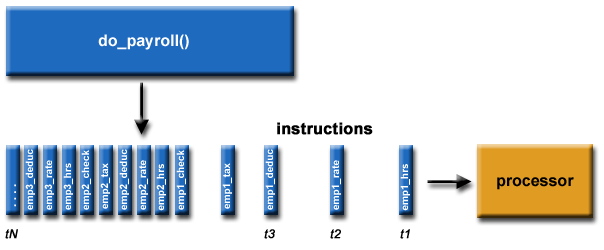
|
||
| Author: Blaise Barney, Lawrence Livermore National Laboratory | UCRL-MI-133316 | |
| Abstract |
This tutorial is the first of eight tutorials in the 4+ day "Using LLNL's Supercomputers" workshop. It is intended to provide only a very quick overview of the extensive and broad topic of Parallel Computing, as a lead-in for the tutorials that follow it. As such, it covers just the very basics of parallel computing, and is intended for someone who is just becoming acquainted with the subject and who is planning to attend one or more of the other tutorials in this workshop. It is not intended to cover Parallel Programming in depth, as this would require significantly more time. The tutorial begins with a discussion on parallel computing - what it is and how it's used, followed by a discussion on concepts and terminology associated with parallel computing. The topics of parallel memory architectures and programming models are then explored. These topics are followed by a series of practical discussions on a number of the complex issues related to designing and running parallel programs. The tutorial concludes with several examples of how to parallelize simple serial programs.
| Overview |
 Serial Computing:
Serial Computing:

For example:

 Parallel Computing:
Parallel Computing:

For example:
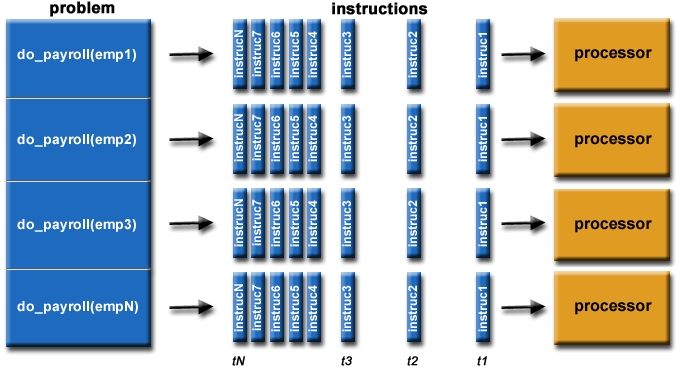
 Parallel Computers:
Parallel Computers:

IBM BG/Q Compute Chip with 18 cores (PU) and 16 L2 Cache units (L2) |

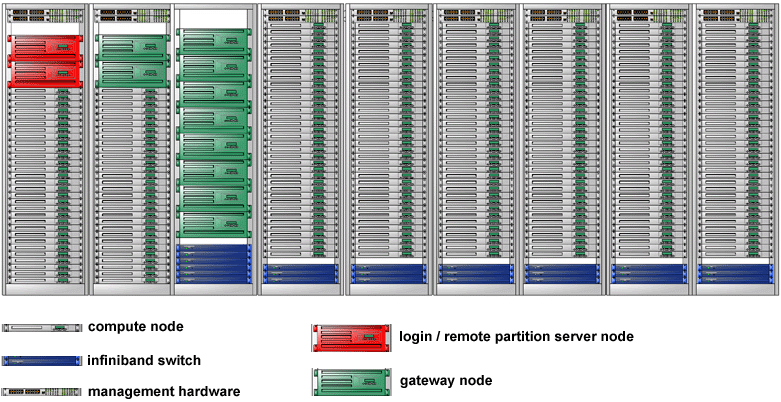

| Overview |
 The Real World is Massively Parallel:
The Real World is Massively Parallel:
|
 Main Reasons:
Main Reasons:
|
| Overview |
 Science and Engineering:
Science and Engineering:
|
 Global Applications:
Global Applications:
| Click on images below for larger version | |
 |
 |
| Concepts and Terminology |
 |
|
 John von Neumann circa 1940s (Source: LANL archives) |
| Concepts and Terminology |
S I S DSingle Instruction Stream |
S I M DSingle Instruction Stream |
M I S DMultiple Instruction Stream |
M I M DMultiple Instruction Stream |
 Single Instruction, Single Data (SISD):
Single Instruction, Single Data (SISD):
|
 |

UNIVAC1 |

IBM 360 |

CRAY1 |

CDC 7600 |

PDP1 |

Dell Laptop |
 Single Instruction, Multiple Data (SIMD):
Single Instruction, Multiple Data (SIMD):
|

|

ILLIAC IV |

MasPar |
 |

Cray X-MP |

Cray Y-MP |

Thinking Machines CM-2 |

Cell Processor (GPU) |
 Multiple Instruction, Single Data (MISD):
Multiple Instruction, Single Data (MISD):
|

|

|
 Multiple Instruction, Multiple Data (MIMD):
Multiple Instruction, Multiple Data (MIMD):
|

|

IBM POWER5 |

HP/Compaq Alphaserver |

Intel IA32 |

AMD Opteron |

Cray XT3 |

IBM BG/L |
| Concepts and Terminology |

Synchronization usually involves waiting by at least one task, and can therefore cause a parallel application's wall clock execution time to increase.
wall-clock time of serial execution ----------------------------------- wall-clock time of parallel execution |
One of the simplest and most widely used indicators for a parallel program's performance.
| Concepts and Terminology |
 Amdahl's Law:
Amdahl's Law:
|

 |
2D Grid Calculations 85 seconds 85%
Serial fraction 15 seconds 15%
We can increase the problem size by doubling the grid dimensions and
halving the time step. This results in four times the number of grid
points and twice the number of time steps. The timings then look like:
2D Grid Calculations 680 seconds 97.84%
Serial fraction 15 seconds 2.16%
 Complexity:
Complexity:
 Portability:
Portability:
 Resource Requirements:
Resource Requirements:
 Scalability:
Scalability:
| Parallel Computer Memory Architectures |
 General Characteristics:
General Characteristics:
|
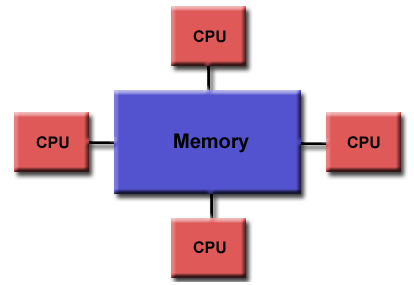
Shared Memory (UMA) 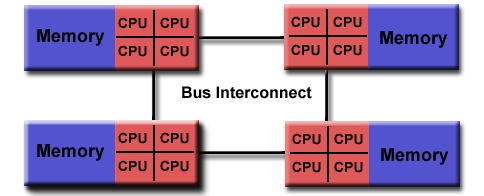
Shared Memory (NUMA) |
 Disadvantages:
Disadvantages:
| Parallel Computer Memory Architectures |
 General Characteristics:
General Characteristics:
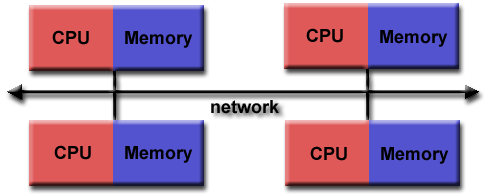
 Advantages:
Advantages:
 Disadvantages:
Disadvantages:
| Parallel Computer Memory Architectures |
 General Characteristics:
General Characteristics:
 |
 |
 Advantages and Disadvantages:
Advantages and Disadvantages:
| Parallel Programming Models |
|
 |
|
 |
| Parallel Programming Models |
 Implementations:
Implementations:
| Parallel Programming Models |

 Implementations:
Implementations:
In both cases, the programmer is responsible for determining the parallelism (although compilers can sometimes help).
 More Information:
More Information:
| Parallel Programming Models |

 Implementations:
Implementations:
 More Information:
More Information:
| Parallel Programming Models |

 Implementations:
Implementations:
| Parallel Programming Models |

| Parallel Programming Models |
 Single Program Multiple Data (SPMD):
Single Program Multiple Data (SPMD):

 Multiple Program Multiple Data (MPMD):
Multiple Program Multiple Data (MPMD):

| Designing Parallel Programs |
| Designing Parallel Programs |
| Calculate the potential energy for each of several thousand independent conformations of a molecule. When done, find the minimum energy conformation. |
This problem is able to be solved in parallel. Each of the molecular conformations is independently determinable. The calculation of the minimum energy conformation is also a parallelizable problem.
Calculation of the Fibonacci series (0,1,1,2,3,5,8,13,21,...) by use of
the formula:
F(n) = F(n-1) + F(n-2)
|
This is a non-parallelizable problem because the calculation of the Fibonacci sequence as shown would entail dependent calculations rather than independent ones. The calculation of the F(n) value uses those of both F(n-1) and F(n-2). These three terms cannot be calculated independently and therefore, not in parallel.
|
 |
| Designing Parallel Programs |
 Domain Decomposition:
Domain Decomposition:


 Functional Decomposition:
Functional Decomposition:

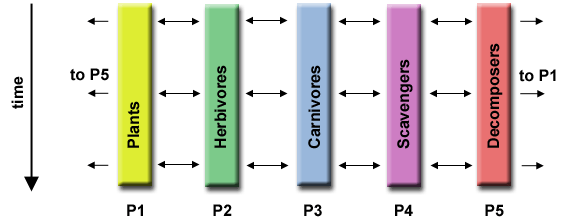


| Designing Parallel Programs |
 Who Needs Communications?
Who Needs Communications?
The need for communications between tasks depends upon your problem:
 Factors to Consider:
Factors to Consider:
There are a number of important factors to consider when designing your program's inter-task communications:


| Designing Parallel Programs |
 Types of Synchronization:
Types of Synchronization:
| Designing Parallel Programs |
 Definition:
Definition:
 Examples:
Examples:
DO 500 J = MYSTART,MYEND A(J) = A(J-1) * 2.0 500 CONTINUE |
The value of A(J-1) must be computed before the value of A(J), therefore A(J) exhibits a data dependency on A(J-1). Parallelism is inhibited.
If Task 2 has A(J) and task 1 has A(J-1), computing the correct value of A(J) necessitates:
task 1 task 2 ------ ------ X = 2 X = 4 . . . . Y = X**2 Y = X**3 |
As with the previous example, parallelism is inhibited. The value of Y is dependent on:
 How to Handle Data Dependencies:
How to Handle Data Dependencies:
| Designing Parallel Programs |

 How to Achieve Load Balance:
How to Achieve Load Balance:
| Designing Parallel Programs |
 Computation / Communication Ratio:
Computation / Communication Ratio:
 Fine-grain Parallelism:
Fine-grain Parallelism:
|

|
| Designing Parallel Programs |

 The Bad News:
The Bad News:
 The Good News:
The Good News:
| Designing Parallel Programs |

| Designing Parallel Programs |

| Parallel Examples |
|

|
|

|
 One Possible Solution:
One Possible Solution:
find out if I am MASTER or WORKER
if I am MASTER
initialize the array
send each WORKER info on part of array it owns
send each WORKER its portion of initial array
receive from each WORKER results
else if I am WORKER
receive from MASTER info on part of array I own
receive from MASTER my portion of initial array
# calculate my portion of array
do j = my first column,my last column
do i = 1,n
a(i,j) = fcn(i,j)
end do
end do
send MASTER results
endif
|
 Pool of Tasks Scheme:
Pool of Tasks Scheme:
Master Process:
Worker Process: repeatedly does the following
find out if I am MASTER or WORKER
if I am MASTER
do until no more jobs
if request send to WORKER next job
else receive results from WORKER
end do
else if I am WORKER
do until no more jobs
request job from MASTER
receive from MASTER next job
calculate array element: a(i,j) = fcn(i,j)
send results to MASTER
end do
endif
|
 Discussion:
Discussion:
| Parallel Examples |
|

|
|

|
| Parallel Examples |
|

find out if I am MASTER or WORKER
if I am MASTER
initialize array
send each WORKER starting info and subarray
receive results from each WORKER
else if I am WORKER
receive from MASTER starting info and subarray
do t = 1, nsteps
update time
send neighbors my border info
receive from neighbors their border info
update my portion of solution array
end do
send MASTER results
endif
|
| Parallel Examples |

where c is a constantA(i,t+1) = (2.0 * A(i,t)) - A(i,t-1) + (c * (A(i-1,t) - (2.0 * A(i,t)) + A(i+1,t)))

find out number of tasks and task identities
#Identify left and right neighbors
left_neighbor = mytaskid - 1
right_neighbor = mytaskid +1
if mytaskid = first then left_neigbor = last
if mytaskid = last then right_neighbor = first
find out if I am MASTER or WORKER
if I am MASTER
initialize array
send each WORKER starting info and subarray
else if I am WORKER`
receive starting info and subarray from MASTER
endif
#Update values for each point along string
#In this example the master participates in calculations
do t = 1, nsteps
send left endpoint to left neighbor
receive left endpoint from right neighbor
send right endpoint to right neighbor
receive right endpoint from left neighbor
#Update points along line
do i = 1, npoints
newval(i) = (2.0 * values(i)) - oldval(i)
+ (sqtau * (values(i-1) - (2.0 * values(i)) + values(i+1)))
end do
end do
#Collect results and write to file
if I am MASTER
receive results from each WORKER
write results to file
else if I am WORKER
send results to MASTER
endif
|
This completes the tutorial.
 |
Please complete the online evaluation form. |
Where would you like to go now?
| References and More Information |